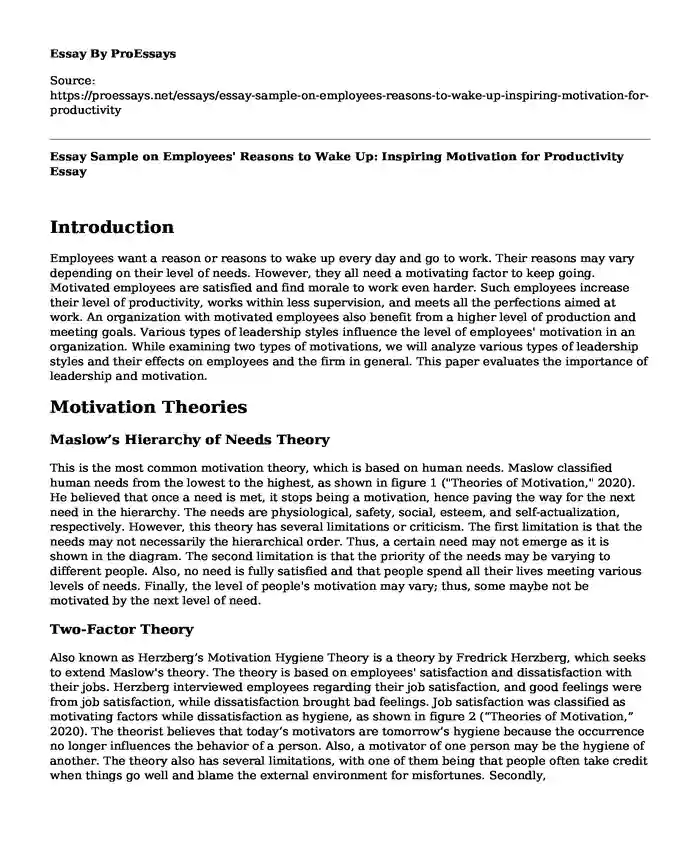Introduction
Employees want a reason or reasons to wake up every day and go to work. Their reasons may vary depending on their level of needs. However, they all need a motivating factor to keep going. Motivated employees are satisfied and find morale to work even harder. Such employees increase their level of productivity, works within less supervision, and meets all the perfections aimed at work. An organization with motivated employees also benefit from a higher level of production and meeting goals. Various types of leadership styles influence the level of employees' motivation in an organization. While examining two types of motivations, we will analyze various types of leadership styles and their effects on employees and the firm in general. This paper evaluates the importance of leadership and motivation.
Motivation Theories
Maslow’s Hierarchy of Needs Theory
This is the most common motivation theory, which is based on human needs. Maslow classified human needs from the lowest to the highest, as shown in figure 1 ("Theories of Motivation," 2020). He believed that once a need is met, it stops being a motivation, hence paving the way for the next need in the hierarchy. The needs are physiological, safety, social, esteem, and self-actualization, respectively. However, this theory has several limitations or criticism. The first limitation is that the needs may not necessarily the hierarchical order. Thus, a certain need may not emerge as it is shown in the diagram. The second limitation is that the priority of the needs may be varying to different people. Also, no need is fully satisfied and that people spend all their lives meeting various levels of needs. Finally, the level of people's motivation may vary; thus, some maybe not be motivated by the next level of need.
Two-Factor Theory
Also known as Herzberg’s Motivation Hygiene Theory is a theory by Fredrick Herzberg, which seeks to extend Maslow's theory. The theory is based on employees' satisfaction and dissatisfaction with their jobs. Herzberg interviewed employees regarding their job satisfaction, and good feelings were from job satisfaction, while dissatisfaction brought bad feelings. Job satisfaction was classified as motivating factors while dissatisfaction as hygiene, as shown in figure 2 (“Theories of Motivation,” 2020). The theorist believes that today’s motivators are tomorrow’s hygiene because the occurrence no longer influences the behavior of a person. Also, a motivator of one person may be the hygiene of another. The theory also has several limitations, with one of them being that people often take credit when things go well and blame the external environment for misfortunes. Secondly,
References
Theories of motivation. (2020). Theories of motivation, Chapter 5. https://saylordotorg.github.io/text_organizational-behavior-v1.1/s09-theories-of-motivation.html
Cite this page
Essay Sample on Employees' Reasons to Wake Up: Inspiring Motivation for Productivity. (2023, Sep 17). Retrieved from https://proessays.net/essays/essay-sample-on-employees-reasons-to-wake-up-inspiring-motivation-for-productivity
If you are the original author of this essay and no longer wish to have it published on the ProEssays website, please click below to request its removal:
- Essay Sample on Dissociative Identity Disorder
- My Goals in the Field of Nursing Essay
- Evidence-Based Practice in the Workplace Paper Example
- Essay Sample on Probationary Firefighter
- Essay Sample on Stress-Related Problems: High Prevalence in Health Care Facility Visits
- Personality Assessment: An ENFJ Perspective - Essay Sample
- Paper Sample on Angelina Jolie - My Icon, My Friend, My Inspiration







